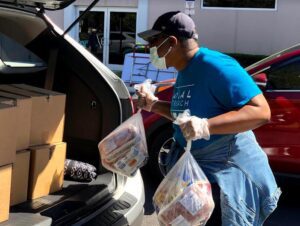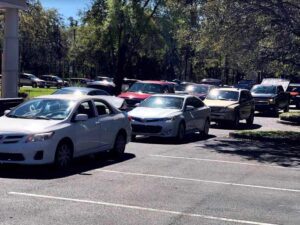
“Just because I have a car doesn’t mean I have enough money to buy food.” This quote, featured in a 2020 New York Times headline, offers a glimpse at the true face of hunger in America – and it’s not what you might expect.
For most adults, the touchstone for “economic disaster” in our country is the 2007-2009 “Great Recession” – a long, slow slog through high unemployment and financial insecurity. But lessons from that crisis don’t necessarily apply here. Back then, we saw a rise in hunger that was spread out over several years, concentrated mainly in low-income populations that had already been facing food insecurity.
Not so during the pandemic. As millions of Americans lost their jobs to closures and layoffs, demand spiked overnight at emergency food providers across the nation. What’s more alarming, many of the families seeking help were facing hunger for the first time. They had never imagined going to a community pantry before.

While it appears we’re on the mend, lines of people at local nonprofit food providers aren’t getting any shorter than they were this time last year.
Why? Florida’s low unemployment rate, which is around 6%, is promising, but it doesn’t tell the whole story. Employers are hiring, but many available jobs are low wage. People have lost any savings they might have had before the pandemic. And as they try to recover, get out of debt, and find their way back to financial security, food is sometimes a negotiable expense.
After all, you can’t forgo paying the rent. You can’t let the power get disconnected. But you can skip meals to cover the difference – and sometimes, your kids have to skip meals, too.
Hunger relief programs can help soften the blow by providing fresh groceries, pantry staples, and nutritious meals to families in need. But it’s a challenge to keep up with the increased demand. At Second Harvest, we’re distributing enough food for 300,000 meals a day, double our average distribution before the pandemic. We’re on track to provide more than 100 million meals this year.
What will it take to get us back to normal? It’s hard to say – but “normal” isn’t what we should strive for.
Even going into the pandemic, Florida never had 100 percent food security. Despite all our efforts, there was a gap in meals – in the multimillions – that left one in seven Floridians food insecure. COVID-19 only cast a harsher light on issues that have always existed in our community: a lack of affordable housing, a rising cost of living, stagnant wages, and a large proportion of our population living paycheck-to-paycheck.
Recovering from those problems is going to be a marathon – not a sprint. And it will take more than just nonprofits, public officials, and activists: We’ll need the whole community to come together and work toward change.
If you’re willing to step up and help, you can make an impact. Do you have some extra time on your hands? Sign up (it’s easy to do online) and volunteer to pack lunches or sort supplies at Second Harvest’s warehouse. If time is tight, consider making a monthly donation pledge instead. One dollar donated allows us to provide nine dollars worth of food to families in need.
Second Harvest is making a difference, but we can’t do it alone. To find out more and get involved, visit www.feedhopenow.org.
Dave Krepcho is president and CEO of Second Harvest Food Bank of Central Florida.


